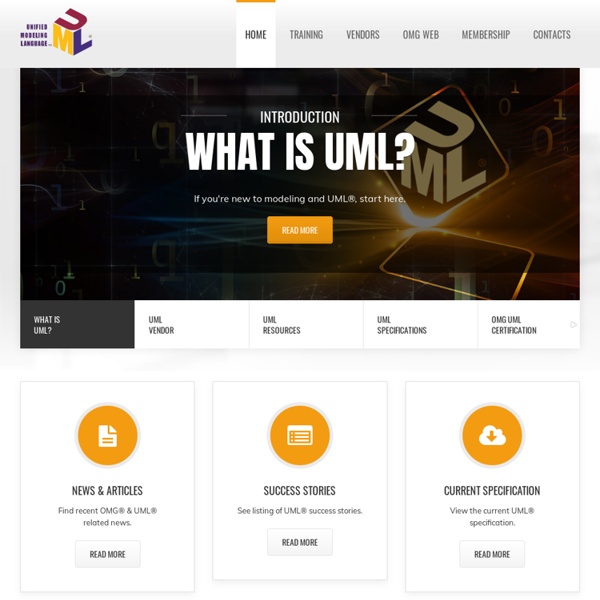Unified Modeling Language - Wikipedia
The Unified Modeling Language (UML) is a general-purpose, developmental, modeling language in the field of software engineering that is intended to provide a standard way to visualize the design of a system.[1] The creation of UML was originally motivated by the desire to standardize the disparate notational systems and approaches to software design. It was developed by Grady Booch, Ivar Jacobson and James Rumbaugh at Rational Software in 1994–1995, with further development led by them through 1996.[1] In 1997, UML was adopted as a standard by the Object Management Group (OMG), and has been managed by this organization ever since. In 2005, UML was also published by the International Organization for Standardization (ISO) as an approved ISO standard.[2] Since then the standard has been periodically revised to cover the latest revision of UML.[3]
Design Codes: UML Class Diagram: Association, Aggregation and Composition
The UML Class diagram is used to visually describe the problem domain in terms of types of objects (classes) related to each other in different ways. There are 3 primary inter-object relationships: Association, Aggregation, and Composition. Using the right relationship line is important for placing implicit restrictions on the visibility and propagation of changes to the related classes, a matter which plays an important role in understanding and reducing system complexity. Association The most abstract way to describe static relationship between classes is using the Association link, which simply states that there is some kind of a link or a dependency between two classes or more. Weak Association
parlezuml.com
A Little Bit of UML (for Just Enough Design) - a very special one-off charity training workshop to celebrate 10 years of parlezuml.com. Saturday August 17th, Bletchley Park. Tickets just 99.
create UML modeling and diagrams
UML models help you understand, discuss, and design software systems. Visual Studio Ultimate provides templates for five of the most frequently used UML diagrams: activity, class, component, sequence, and use case. In addition, you can create layer diagrams, which help you define the structure of your system. You need Visual Studio Ultimate to create UML models. UML modeling diagrams and layer diagrams can exist only inside a modeling project. Each modeling project contains a shared UML model and several UML diagrams.
UML For Business Analysts
Skip to main content Real IRM Leading Enterprise Architecture Value™
UML modeling and code generation in Visual Studio 2010
This article provides an overview of UML modeling in Visual Studio 2010. Assuming that reader is already familiar with UML, it focuses on custom UML profiles - an extensibility mechanism that can be used to tailor UML models to a particular problem domain. Readers will see an example of such a profile, which extends UML Class Diagrams for database modeling. Finally, the article shows how code can be generated from UML models using T4 text templates.
Unified Modeling Language
Useful Links to UML resources If you have, or know of, a link that we should add to these lists, send an email to Dr. Jon Siegel, OMG's Vice President, Technology Transfer at siegel AT omg.org.
UML Tutorial - UML Unified Modelling Language - Sparx Systems
The Unified Modeling Language (UML) has quickly become the de-facto standard for building Object-Oriented software. This tutorial provides a technical overview of the 13 UML diagrams supported by Enterprise Architect. UML 2 semantics are explained in detail in the new UML 2.0 tutorial. Firstly...
Papyrus User Guide
UML modeling Getting Started Papyrus Perspective The Papyrus perspective contains : Model Explorer view Outline view Multi diagram editor view Properties view Toolbar
Homepage - Free UML Tool
New in UMLet 14.2 stand-alone and UMLet 14.2 Eclipse plugin - Fixed pixel displacements on exports - Improved relations - New option to embed pdf font - Many additional fixes; see the github issue tracker New in UMLet 14.1.1 stand-alone and UMLet 14.1 Eclipse plugin - New custom elements - New sequence all-in-one - OS-specific config dir handling New in UMLet 13.3 stand-alone and UMLet 13.3 Eclipse plugin - Opaque elements (command: transparency=) - Line color handling improved New in UMLet 13.2 stand-alone and UMLet 13.2 Eclipse plugin - Improved relations - Various zoom issues fixed



